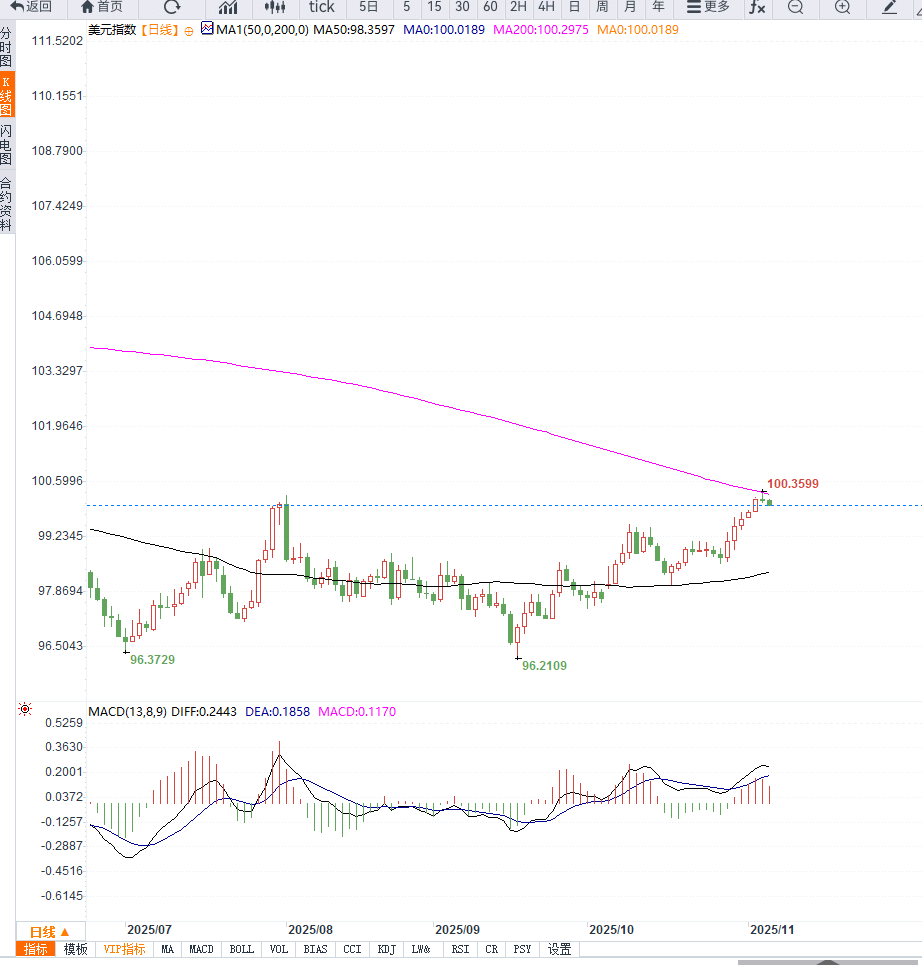The US dollar index rose and then fell back; in the short term, attention will continue to focus on changes in expectations of a Federal Reserve rate cut.
2025-11-06 14:04:52
Since October 1, the government shutdown has persisted due to Congress's failure to reach an agreement on the fiscal budget, and the resulting fiscal and economic uncertainty has increased downward pressure on the US dollar.
The Senate did not schedule a vote on Thursday on the reopening bill that had already passed the House of Representatives, after the bill failed to advance for 14 consecutive times.
 With official employment data delayed due to the government shutdown, the market turned its attention to the ADP private sector employment data. The U.S. private sector added 42,000 jobs in October, significantly better than the revised figure of 29,000 losses in the previous month, and also higher than the market expectation of 25,000.
With official employment data delayed due to the government shutdown, the market turned its attention to the ADP private sector employment data. The U.S. private sector added 42,000 jobs in October, significantly better than the revised figure of 29,000 losses in the previous month, and also higher than the market expectation of 25,000.This data provided some support for the US dollar and also showed that the labor market remains resilient. As for the Federal Reserve, after two consecutive rate cuts, Chairman Jerome Powell stated that the labor market was "moderately cooling," but did not specify the necessity of another rate cut.
Federal Reserve Governor Stephen Miran said the October jobs data was “surprisingly good” and hinted that a further rate cut might be needed in December, saying that current policy is still too tight and carries unnecessary risks.
The market will be closely watching speeches by several Federal Reserve officials this Thursday, including Michael Barr, John Williams, Anna Paulson, Beth Hammack, Christopher Waller, and Alberto Musalem. A hawkish tone in their speeches could lead to a short-term strengthening of the US dollar.
In summary, the DXY is currently in a period of fluctuation and adjustment amid intertwined fiscal risks and labor market data. The short-term dollar trend remains highly dependent on comments from Federal Reserve officials and the progress of the government shutdown.
The daily chart shows that the DXY price has been fluctuating between 100.00 and 101.00 recently. The price briefly dipped to around 100.05, testing the previous support level of 100.00, and has entered a period of weak consolidation.
In terms of technical indicators, the RSI is close to 45, indicating weak momentum, while the daily moving averages (20-day and 50-day moving averages) have shown a slowdown in their rise and are flattening out, which means that the forces of bulls and bears are balanced in the short term and there is a lack of clear direction.
If the DXY index breaks below the 100.00 support level, it will open up downside potential, potentially testing the 99.50–99.30 area. Conversely, if it rebounds and breaks through the 101.00–101.20 resistance zone, it may rise to 101.50 in the short term.
Overall, the US dollar index remains in a weak and volatile pattern on the daily chart. Attention should be paid to the immediate impact of the Federal Reserve's statements and the progress of the government shutdown on the market.

Editor's Note:
The recent movement of the US dollar index exhibits a typical event-driven pattern: fiscal risks and economic data are intertwined, making it difficult to determine the short-term bullish or bearish trend. The historic government shutdown has put pressure on the dollar, but the resilience of employment data has provided support.
Attention should be paid to speeches by Federal Reserve officials and fiscal developments. Until a clear breakthrough is seen, the market is expected to remain range-bound. If subsequent hawkish comments from officials or easing fiscal risks, the dollar may regain upward momentum; conversely, an extended government shutdown or heightened economic concerns will continue to put pressure on the dollar index.
- Risk Warning and Disclaimer
- The market involves risk, and trading may not be suitable for all investors. This article is for reference only and does not constitute personal investment advice, nor does it take into account certain users’ specific investment objectives, financial situation, or other needs. Any investment decisions made based on this information are at your own risk.





















